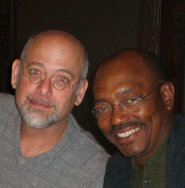Iatrogenica
A chance encounter with an old friend leads our editorial advisor to reminisce about patients past.
I was in Toronto, a beautiful city, and the site of a great Internal Medicine 2010 meeting. While walking through the crowd, I heard someone call my name. The way he said “JAY-mie NEW-man” was unmistakable. It was my long-lost friend, ex-running partner, and still man-about-town, Harvey Wayne Bowles.
Now an ace internist in Nashville, Harvey is an old war buddy of mine, having survived a tour of duty at the old Ben Taub hospital and residency at the Baylor College of Medicine in Houston in the mid 1980s.

We sat down that night in a small jazz club on Queen Street and “ran the list,” remembering people and cases from the past. What amazed me was how we both remembered certain patients 25 years later.
One case stuck in my mind for years. In my head I called her the Iatrogenic Poster Girl. I had not thought of her for years, until the esteemed Dr. Bowles said, “Remember that old girl with the chest X-rays?”
It was the perfect storm of iatrogenesis. A diabetic woman was admitted to the hospital with pneumonia. She was admitted to a busy hospital service, to harried, overworked and underfed residents.
The first X-ray showed a multilobar pneumonia.
When she reached the floor she had no IV access; her veins were shot. By protocol patients were supposed to come to the floor with access. The resident could have put the line in herself, but was tired or grouchy or lazy; we will never know. So the resident sent her back down to the ER to get a line. An overloaded surgeon attempted to slip a left subclavian line in with difficulty. It was his second time ever putting in a line. Unable to get access, he tried on the right and was finally successful. The patient was sent back to the floor, passing through radiology on the way.
The second X-ray showed a multilobar pneumonia, a right subclavian line and a left pneumothorax.
A different surgical resident came to place the chest tube, and seeing the subclavian on the right, he slipped the chest tube in there, assuming that to be the side of the pneumothorax.
The third X-ray showed a multilobar pneumonia, a right subclavian line, a left pneumothorax and a right-sided chest tube. Another chest tube was inserted.
The fourth X-ray showed a multilobar pneumonia, a right subclavian line, a right-sided chest tube and a left-sided chest tube. The first chest tube was removed.
Later that evening the patient had a cardiac arrest. Anesthesia was called. She was nasally intubated with difficulty, and came to me in the ICU.
The fifth X-ray showed a multilobar pneumonia, a right subclavian line, a right-sided chest tube and a #7 endotracheal tube in the stomach.
The patient survived.
Sitting in the jazz bar, listening to a crazy riff from an electric guitar, a bass and drums, my mind tried to find the pattern in the music. The melody was not smooth; it was not easy listening, but it told a musical story. I thought about this case—also not a simple rhythm with a predictable course.
This is a tale of patient safety. Cold statistics and dense tables of data do not give the reader the sense of disaster and mayhem that are the essence of medical error: wrong limbs amputated, wrong medications given, bedsores, infected lines and catheters not monitored. These elements of safety are more than epidemiologic data; to the patients, they are disaster.
Will our current-day residents meet at an ACP meeting 25 years from now as old war buddies, having lived through similar experiences?
Residency work hours and a focus on safety have changed the housestaff tableau—some say for better, others not. Some physicians feel the current training programs are too lax in hours and experience. Others, perhaps the patients especially, might feel better supervision and less fatigue are preferable.
There are many lessons to be learned from iatrogenesis.



